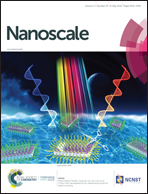Carboxylic acid-capped ruthenium nanoparticles: experimental and theoretical case study with ethanoic acid†
Abstract
Given that the properties of metal nanoparticles (NPs) depend on several parameters (namely, morphology, size, surface composition, crystalline structure, etc.), a computational model that brings a better understanding of a structure–property relationship at the nanoscale is a significant plus in order to explain the surface properties of metal NPs and also their catalytic viability, in particular, when envisaging a new stabilizing agent. In this study we combined experimental and theoretical tools to obtain a mapping of the surface of ruthenium NPs stabilized by ethanoic acid as a new capping ligand. For this purpose, the organometallic approach was applied as the synthesis method. The morphology and crystalline structure of the obtained particles was characterized by state-of-the art techniques (TEM, HRTEM, WAXS) and their surface composition was determined by various techniques (solution and solid-state NMR, IR, chemical titration, DFT calculations). DFT calculations of the vibrational features of model NPs and of the chemical shifts of model clusters allowed us to secure the spectroscopic experimental assignations. Spectroscopic data as well as DFT mechanistic studies showed that ethanoic acid lies on the metal surface as ethanoate, together with hydrogen atoms. The optimal surface composition determined by DFT calculations appeared to be ca. [0.4–0.6] H/Rusurf and 0.4 ethanoate/RuSurf, which was corroborated by experimental results. Moreover, for such a composition, a hydrogen adsorption Gibbs free energy in the range −2.0 to −3.0 kcal mol−1 was calculated, which makes these ruthenium NPs a promising nanocatalyst for the hydrogen evolution reaction in the electrolysis of water.



 Please wait while we load your content...
Please wait while we load your content...